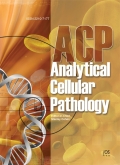Authors: Edgerton, Mary E. | Chuang, Yao-Li | Macklin, Paul | Yang, Wei | Bearer, Elaine L. | Cristini, Vittorio
Article Type:
Research Article
Abstract:
We introduce a novel “mathematical pathology” approach, founded on a biophysical model, to identify robust patient-specific predictors of tumor growth useful in clinical practice to improve the accuracy of diagnosis/prognosis and intervention. In accordance with biological observations, our model simulates the diffusion-limited in situ tumors with a relatively short phase of fast initial growth, followed by a prolonged slow-growth phase where tumor size is constrained primarily by the relative weight of cell mitosis and death. The former phase may only last for a few months, so that at the time of diagnosis, we may assume that most tumors will have
…entered the phase where their size is changing slowly. Based on this prediction, we hypothesize that the volume of breast with ducts affected by in situ tumors at the time of diagnosis will be closely approximated by a model-derived mathematical function based on the ratio of tumor cell proliferation-to-apoptosis indices and on the extent of diffusion of cell nutrients (diffusion penetration length), which can be measured from immunohistochemical and morphometric analysis of patient histopathology specimens without the need for multiple-time measurements. We tested this idea in a retrospective study of 17 patients by staining breast tumor specimens containing ductal carcinoma in situ for mitosis with Ki-67 and for apoptosis with cleaved caspase-3 and counting cells positive for each marker. We also determined diffusion penetration by measuring the thickness of viable rims of tumor cells within ducts. Using the ensuing ratios, we applied the model to determine a predicted surgical volume or tumor size. We then corroborated our hypothesis by comparing the predicted size of each tumor based on our model with the actual size of the pathological specimen after tumor excision (R2 = 0.74—0.88). In addition, for the 17 cases studied, both histological grade and mammography were not found to correlate with tumor size (R2 = 0.08—0.47). We conclude that our mathematical pathology approach yields a high degree of accuracy in predicting the size of tumors based on the mitotic/apoptotic index and on diffusion penetration. By obtaining these ratios at the time of initial biopsy, pathologists can employ our model to predict the size of the tumor and thereby inform surgeons how much tissue to remove (surgical volume). We discuss how results from the model have implications concerning the current debate on recommendations for screening mammography, while the model itself may contribute to better planning of breast conservation surgery.
Show more
Keywords: DCIS, mathematical model, patient histology, IHC analysis, cell proliferation, cell death
DOI: 10.3233/ACP-2011-0019
Citation: Analytical Cellular Pathology,
vol. 34, no. 5, pp. 247-263, 2011
Price: EUR 27.50





